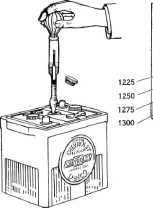1942 - 1947 CHEVROLET SHOP MANUAL
Section 12 - Electrical System
|
|
||||
|
12-4
|
||||
|
|
||||
|
the horseshoe magnet down over the wire the lines
of force will be cut by the wire
and in so doing a current
is generated by the principle of electro
magnetic induction. In this case
we are moving the magnetic field so that the lines of force cut
across the conductor.
In both of the foregoing illustrations we were
using mechanical movements;
however, it is also
possible to move the magnetic field electrically.
This is the means used in
producing the high tension
current in the coil of our ignition system.
THE CHEVROLET-DELCO BATTERY
The storage battery, Fig. 8. may be considered
a tank or reservoir in which
eneregy from the gen-
|
When this electro-chemical action known as
"charging" has been completed, it
is only necessary to make a
continuous, uninterrupted circuit between the positive and
negative terminals of the battery, through the wiring system and
electrical apparatus of the car,
in order to produce electricity, and when used for a sufficient
length of time, the
battery is changed to its original or "discharged" condition.
Electric current is generated in the battery in as full a sense as in
an electric generator.
From the foregoing it is obvious that the efficiency of the battery
is in direct proportion to its state of charge: also that in order to
obtain the maximum efficiency from
the battery, whatever amount of current is withdrawn from or
generated by the battery must be
compensated for by running
the generator long enough to restore the battery
plates to the condition known as "charged."
The construction of a storage battery is extremely
simple. A battery possesses three compartments
or cells. Within each cell are two elements,
one positive ( + ), and the other negative
(-). Each element consists of a
number of plates called "grids," the openings of which are filled with
a lead paste. Each group of
plates is connected
together and the positive are separated from the
negative group by porous
separators between each
plate.
The liquid in which these plates are immersed
is called electrolyte (sulphuric
acid and water). When the
battery is being charged, acid is driven
from combination in the plates
and causes the specific
gravity of the solution to rise. When the battery
discharges, the acid combines with the paste
material of the plates, forming a
chemical compound, and the
specific gravity falls, until in the
case of a completely discharged
battery, the solution is
practically all distilled water.
The battery, while undergoing a charge, emits
gases, during which the battery is
said to be "gassing." It
also has a tendency to heat if the charging
rate is abnormally high; therefore, it is essential
that distilled water be added
from time to time to
replace the loss in water due to this "gassing"
(which results from the
decomposition of the
water).
At the top of each
cell is a vent or opening accessible by unscrewing the vent or cell
cap. Immediately upon receipt of
a battery or a new automobile, the battery should be
inspected. All cell caps should be removed and the level of the
solution in each cell checked.
Due to the location of the battery under the
hood on passenger cars, it is
most important that the
water level be checked more frequently than
|
|||
 |
 |
|||
|
READING FOR FULLY
CHARGED BATTERY SHOULD BE BETWEEN 1275 AND 1300
|
||||
|
Fig. 8-Testing Specific Gravity of Battery
erator may be accumulated and stored until it is
required.
Since the performance of the electrical equipment
depends to a great extent on the condition of the storage
battery, its function should be thoroughly
understood.
The battery, popularly referred to as "storage
battery," gives rise to a false
conception of the true
nature of the battery. The battery is in reality an electro-chemical
apparatus.
Electricity is not actually stored in the battery
until needed but is caused to flow
into the battery and out by
means of two wires attached to it.
None of the electricity stays
there; certain changes
merely take place within the battery itself.
Charging a battery by causing electric current
to flow through it sets up a
certain electrochemical
action between the positive and negative plates in the presence of the
battery fluid or electrolyte.
|
||||
|
|
||||